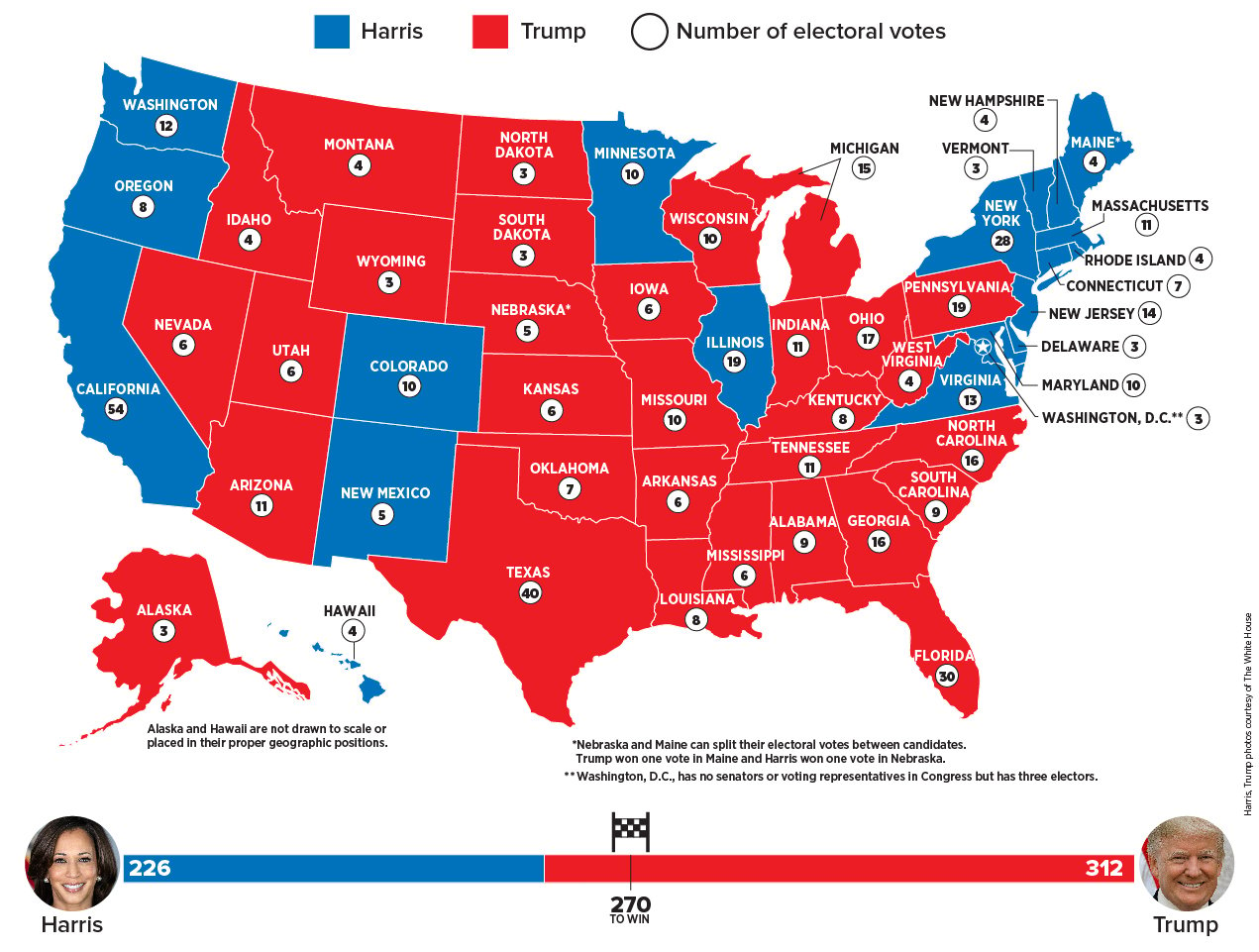After one of the most tumultuous campaigns in modern American history, former President Donald Trump will return to the White House in January.
The New York Times, the Associated Press, and most other media outlets on Wednesday morning projected Trump, a Republican, as the winner of the presidential election after he clinched a victory in Wisconsin. That win gave him and his running mate, Ohio Senator J.D. Vance, 277 electoral votes—seven more than needed for victory in the Electoral College. Several states were still counting ballots.
Vice President Kamala Harris, the Democratic nominee, and her running mate, Minnesota Governor Tim Walz, have won 224 electoral votes.
Trump is set to become the nation’s 47th president after he takes the oath of office on January 20. He’s the first president to win two nonconsecutive terms in the White House since Grover Cleveland won reelection in 1892. At 78, he becomes the oldest person ever elected president, surpassing President Biden, who was 77 when he won election in 2020.
“I will not rest until we have delivered the strong, safe, and prosperous America that our children deserve,” Trump said in a speech to supporters early Wednesday morning. “This will truly be the golden age of America.”
Vice President Harris was expected to speak later today.
Though the polls had predicted one of the closest presidential votes in history, with the nation’s eyes trained on the seven battleground states, Trump has already captured Pennsylvania, Georgia, North Carolina, and Wisconsin and was ahead in Michigan, Arizona, and Nevada, exceeding the expectations of many pundits. He’s also ahead in the popular vote, with more than 71 million to Harris’s 66 million, according to The New York Times. His victory completes a political comeback after voters rejected Trump’s reelection bid in 2020.
Experts say Trump’s victory points to the dissatisfaction many Americans feel about the state of the world and the nation, especially around the economy and immigration, two of the biggest issues in the campaign. In a deeply divided nation, voters embraced Trump’s pledge to seal the southern border by almost any means, to revive the economy with 19th-century-style tariffs that would restore American manufacturing, and to lead a retreat from international entanglements and global conflict. They also decided to overlook Trump’s legal troubles, including multiple indictments over his alleged efforts to overturn the results of the 2020 election.
“It's a mistake to think that Trump voters are only thinking about what things were like between 2017 and 2021 when Trump was president,” says Bernard Fraga, a political science professor at Emory University in Atlanta. “[His victory] indicates that there's still a lot of concern about the direction of the country.”
When he takes office Trump will, at the very least, have a Republican Senate to work with. Republicans picked up three Senate seats from Democrats to win a 52-48 majority. The House, narrowly controlled by Republicans since the 2022 midterms, remained too close to call Wednesday morning. A Republican-controlled Congress would allow Trump to enact his agenda with minimal opposition.
No matter how they voted, Americans were very engaged in the election overall. Trump was seeking to reclaim the presidency, and Harris was vying to become the first woman to win the White House. Supporters of both candidates predicted dire consequences for the nation in the event their candidate lost.
In results so far, 64.5 percent of eligible Americans voted, according to estimates by the University of Florida’s Election Lab. That falls just short of the 66.8 percent of eligible voters who cast ballots in 2020, which had the highest voter turnout of the 21st century. More than 80 million people voted before Election Day—either in person or using a mail-in ballot.
With his victory, Trump must find a way to lead a nation that in many respects has behaved like two separate nations—one red and one blue. A big question heading up his inauguration will be whether he decides to try to unite America or to continue to depict his opponents as enemies of the nation. Either way, the way forward won’t be easy.
“It is very hard for presidents to unify the country and really build a base of support behind them,” says Barry Burden, director of the Elections Research Center at the University of Wisconsin-Madison. “The electorate is so polarized [and] presidents just have to march on and try to do the best they can despite that.”
With reporting by Ali Watkins, Michael Gold, Shane Goldmacher, and Lisa Lerer of The New York Times.

